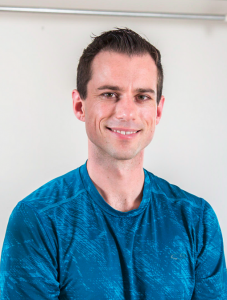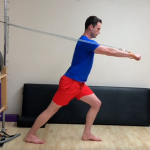June 12, 2019
Bringing it Back to Gravity
by Adam McAtee
For one reason or another, we live in a time where countless individuals in developed countries struggle to adequately complete a full-range squat and are potentially living with a dysfunctional gait. These limitations may not only inhibit their daily functions but may result in them living with unnecessary discomfort. Thankfully, one of the most defining features of Pilates is how we can manipulate a body’s relationship to gravity allowing that individual to inhabit a range of motion that would otherwise be unachievable. This experience not only enhances a student’s muscular strength, but also sends necessary nutrients to permeate their joints while leaving them with a sense of relief, power, and vitality.
Why and how does this work?
That is not a simple question to answer. So, to simplify things, I often consider a 2-dimensional model when contemplating external forces applied to the body by springs, gravity, mats, poles, etc. In the case of footwork on the Reformer, gravity is a vertical external force (y-axis) and the springs apply horizontal force (x-axis). When performing footwork, the spring force is the dominant external force and gravity may be considered negligible. Many students, ranging from athletes to retired schoolteachers, experience a feeling of liveliness and vigor as a result of being able to generate submaximal force onto the foot-bar without their weight (mass x gravity) compressing their joints in the process.
When considering the same exercise on the Wunda Chair, the spring force may be considered a vertical force applied which runs antiparallel with gravity, but the dynamics of the chair allow one to apply downward forces onto the pedal to model a “sit-to-stand” or squat. During Step-ups on the Wunda Chair, the vertical force provides the necessary assistance to allow a student to model climbing up a large step. These exercises have immense value — not only get our clients upright, but to better model particular tasks that match their daily lives.
Too many private sessions and classes go by with minimal, if any, standing exercises and it’s a vital part of the system. Many students I have worked with simply just want to lay supine and get credit for working out. Yes, we should have them lie down (especially, to begin a session), but as the body temperature rises, I say it’s vital to get people upright and in alignment with gravity. There are plenty of upright movements throughout the system (Elephant, Up-Stretch, Gondola, Scooter, etc.), but when appropriate, it can be of added value to transfer these movements to more relatable tasks they experience in their daily lives.
For example, most of our students are able-bodied and walk throughout their day. Although there are many ways we can affect an individual’s gait (e.g. gluteus medius activation via loaded side-splits) within the classical method, I find it imperative to remind my students of the pulling action that is available to them via static friction with every step throughout their gait cycle. The hip extensor strength applications on the Pilates reformer can be experienced via bridges, bottom lift, as well as knee stretches; the motor control aspects are displayed well during elephant and up-stretch. However, one could argue that they may fail to bridge the gap between enhancing the student’s awareness of how to properly utilize the hip extensors in activities of daily living including, but not limited to, walking. To further bridge the gap, I encourage the Pilates community to employ the standing exercises created by Clara, Joe, and the elders while also giving yourself permission to be your own creative genius to design a movement sequence for the body in front you. In the video below, I illustrate how I do this with those whom I am blessed able to spend my time with.
https://www.youtube.com/watch?v=Ns6oTqYW_J4
It is remarkable to be able to have someone lie down and then have them move their body in ways unimaginable to them. However, when appropriate for the student, the gain truly lies in the ability to apply the work when in alignment with gravity. The value of the Pilates system is simply immeasurable, and I appreciate the work that has been created by those who have come before us as well as the innovators of today. I am here to say you have permission to be your own creative genius while also encouraging you to know the source of this work — an exploratory prodigy that designed exercises and apparatuses for individuals he interacted with. I invite you to be in the energy of the creator, use the tools that have been provided for us, and also seek to know how and why the toolmaker created them.
There is a genius in you and your students deserve to experience it.
 Adam McAtee has been teaching Pilates since 2010 and is classically certified through The Pilates Institute of Southern California. With his lust for further education Adam has chosen to pursue a Bachelor’s of Science in Kinesiology Exercise Science at California State University Long Beach in which he is currently enrolled.
Adam McAtee has been teaching Pilates since 2010 and is classically certified through The Pilates Institute of Southern California. With his lust for further education Adam has chosen to pursue a Bachelor’s of Science in Kinesiology Exercise Science at California State University Long Beach in which he is currently enrolled.
Adam has spent his years teaching in boutique studios, big box gym, schools, as well as physical therapy clinics. Through the diversity of these settings Adam has expanded on his classical training to include more contemporary as well as therapeutic exercises to add more tools to his tools box. To get in touch with Adam you reach out to his instagram feed @Adam_McAtee_Pilates

